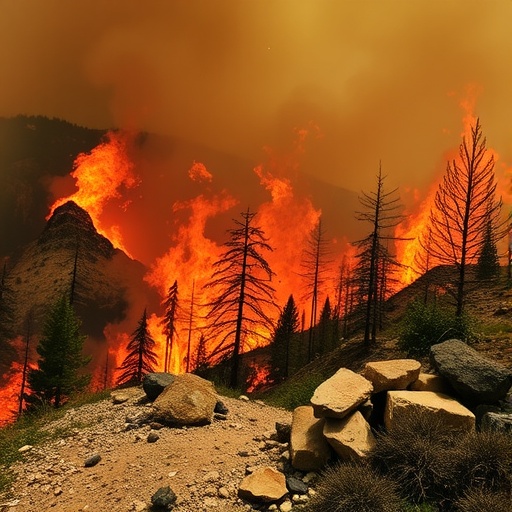As wildfires scorch landscapes across the globe with increasing ferocity, a new comprehensive study has brought to light the profound and far-reaching consequences of these blazes under the accelerating influence of global warming. The research, conducted by Zhao and colleagues and published in Nature in 2025, deploys an innovative machine learning framework to project future wildfire patterns, their greenhouse gas emissions, and, critically, their escalating impacts on human health and climate systems.
For decades, wildfires have been recognized as dramatic agents of environmental transformation, releasing vast quantities of carbon dioxide and fine particulate matter into the atmosphere. However, prior global projections of wildfire activity and emissions have suffered from gaps and uncertainties, limiting the ability of policymakers to craft effective interventions in a warming world. Addressing this deficit, the research team developed an interpretable machine learning methodology that integrates varied climatic and socioeconomic factors to predict burned areas and associated emissions with unprecedented spatial and temporal resolution.
From 2010–2014 to the closing years of this century (2095–2099), the study forecasts a striking 23% increase in fire carbon emissions under the Shared Socioeconomic Pathway 2-4.5 (SSP2-4.5) scenario—a middle-of-the-road trajectory balancing emissions and adaptation efforts. This increase signals not just a quantitative change but a profound qualitative shift in how wildfires redefine terrestrial ecosystems, air quality, and climate dynamics.
Wildfire aerosols, particularly fine particulate matter (PM₂.₅), have long been double-edged swords: contributing to atmospheric cooling by reflecting sunlight, yet inflicting severe respiratory and cardiovascular harm upon exposed populations. Intriguingly, the team’s projections indicate that the aerosol-induced cooling effect in high northern latitudes—specifically north of 60°N—will diminish from 0.06 watts per square meter, implying a complex feedback where warming diminishes this natural atmospheric thermostat.
Central to this investigation is the human toll of wildfire smoke. Fine particulate pollution is a silent killer, infiltrating airways and circulation systems and exacerbating myriad health conditions. The projections estimate a surge in premature deaths attributable to wildfire PM₂.₅, reaching an annual toll of approximately 1.40 million individuals worldwide by 2095–2099. This figure represents a staggering six-fold increase from contemporary levels, an alarming escalation that underscores the urgency of integrating health outcomes into climate-fire policy frameworks.
Geographically, the burden of wildfire-induced premature mortality will not be distributed evenly. Africa emerges as the region poised to suffer the most severe escalation, with an elevenfold increase in deaths linked to wildfire smoke exposure. This stark rise is attributed not only to augmented fire emissions but also to a demographic shift towards an aging population, more vulnerable to respiratory insults, compounding the health crisis.
Meanwhile, Europe and the United States are projected to face a more moderate, yet still significant, rise in smoke-related mortality—between one and two times current rates. These increases correlate with the documented intensification of fire events in the mid-latitude Northern Hemisphere, which threatens densely populated regions and challenges existing emergency response capacities.
Beyond raw statistics, the study reveals a worrying trend towards a more equitable but devastating health burden across global development gradients. Historically concentrated in lower-income, less resilient regions, wildfire health impacts are forecast to spread with increasing intensity across nations of varying socioeconomic status. This reshaping of inequality highlights the imperative for coordinated international efforts aimed at prevention, mitigation, and adaptation strategies that transcend borders.
From a methodological standpoint, the research leverages a state-of-the-art interpretable machine learning model trained on historical fire data, climate variables, and socioeconomic projections. This framework allows not only for accurate predictions but also for transparent assessments of the relative importance of various climatic drivers—such as temperature, humidity, and precipitation patterns—in shaping fire regimes under future climates.
Moreover, the approach accounts for complex interactions between emissions, atmospheric chemistry, and health outcomes. By quantifying radiative forcing changes due to wildfire aerosols alongside health burden projections, the model bridges the gap between environmental and public health domains, offering a holistic perspective rarely achieved in wildfire research.
The findings carry profound implications for climate policy and public health planning. As fire seasons lengthen and intensify globally, wildfire management cannot be siloed into forestry or disaster response sectors alone. Instead, integrating health impact forecasting and emission reduction strategies, alongside socioeconomic considerations, will be crucial to mitigate the compounded risks posed by wildfires.
In conclusion, Zhao et al.’s work delivers a stark warning of a future where wildfires become more devastating not only in scale and intensity but in the human suffering they engender. By illuminating the pathways through which climate change exacerbates wildfire emissions and health impacts, this research provides a critical foundation for informed, coordinated global action aimed at protecting both planetary and human health.
Subject of Research:
Global projections of wildfire activity, emissions, and associated health impacts under climate change.
Article Title:
Global warming amplifies wildfire health burden and reshapes inequality.
Article References:
Zhao, J., Zheng, B., Ciais, P. et al. Global warming amplifies wildfire health burden and reshapes inequality. Nature (2025). https://doi.org/10.1038/s41586-025-09612-9
Image Credits:
AI Generated
Tags: carbon emissions increase from wildfiresclimate change and fire managementenvironmental transformation due to wildfiresfuture wildfire patterns predictionglobal warming effects on wildfiresgreenhouse gas emissions from wildfiresmachine learning in climate researchpolicy implications of wildfire researchpublic health impacts of wildfiressocioeconomic factors in wildfire projectionsspatial and temporal wildfire analysiswildfire health risks





